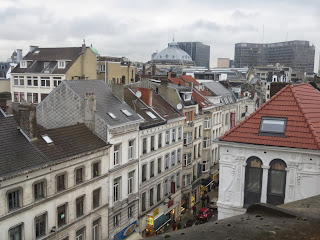First, some background! Belgium is located between France, Germany, and the Netherlands. The country gained independence from the Netherlands in 1830, apparently when a revolution began in Brussels after the performance of a particularly incendiary opera. That's right: an opera. Those crazy Europeans.
History has not been very kind to Belgium, mostly due it's placement around several European superpowers, and it took quite a licking in World Wars I and II. Thankfully, though Brussels was occupied by the Germans during the second world war, it didn't take much damage and it's beautiful buildings are still intact. Currently, it is a parliamentary democracy (the current King is Albert (II) and its main business is government--both NATO and the EU have principal institutions here.
Despite its small size (comparable to my home city of Washington, DC), Brussels is a city of divisions. Most notably, there are three principal languages spoken here: French, Dutch, and Flemish (which is actually really similar to Dutch), and the city is officially bilingual in French and Dutch. You could also argue that English is an unofficial fourth language, since so many of the people seem to speak it. Especially around the more touristy areas and in the service industry. Brussels is also divided by geography: a north-south ridgeline divides the city into the older Lower Town and the more modern feeling Upper Town.
 The Lower Town is centered around the medieval-looking square, the Grand Place (pronounced Grand Plahs). The main buildings in the square are the Town Hall, the City Museum (previously known as the King's House and Breadhouse) and beautiful old row houses that held the city's guildhalls. The architecture is similar to Amsterdam with just a touch of gilding to make it look classy. The current buildings are more impressive on the outside than inside, but the City Museum had a really interesting look at the history of the building and a huge (and fun) collection of costumes worn by the statue, the Mannekin-Pis (more on that later).
The Lower Town is centered around the medieval-looking square, the Grand Place (pronounced Grand Plahs). The main buildings in the square are the Town Hall, the City Museum (previously known as the King's House and Breadhouse) and beautiful old row houses that held the city's guildhalls. The architecture is similar to Amsterdam with just a touch of gilding to make it look classy. The current buildings are more impressive on the outside than inside, but the City Museum had a really interesting look at the history of the building and a huge (and fun) collection of costumes worn by the statue, the Mannekin-Pis (more on that later).The square is surrounded by restaurants, cafes, some shops, and chocolatiers--including outposts of the famous Godiva, Neuhaus, and Leonidas brands.
Detail view of the former guildhalls--now shops and restaurants.
The Swan House--the bar where Karl Marx and Frederick Engels met in February 1848 to write the Communist Manifesto. Next door on the left is the Brewery Museum, which is by all accounts pretty lame.
It was actually sunny here for a good part of the day on Saturday. Surprising since it has rained every day! Here's a look at the City Museum (formerly the "King's House").
The second most famous site in the Lower Town is the Mannekin Pis (literally translates to Little Man Pee). As advertised, it is a two foot tall bronze statue of a boy peeing. The original statue dates from 1691, but the statute is popular among thieves, and the current statute was made in 1965.
There's a bunch of legends behind the origin of the statue--most famously that it commemorates an incident in the fourteenth century when a small boy saved the city from blowing up by urinating on the burning fuse to some explosives. According to my Rick Steve guidebook though, the statue was actually commissioned by the city of Brussels as a celebration of the city's sense of freedom and fun--which I guess means drinking so much beer that you end up having to pee pretty much constantly. I'm not really sure WHY this statute is so popular and iconographic, but it's cute. And apparently, dressing the statute up in costumes is a big tradition--many outfits have been donated from other countries and cities across the world and they are displayed at the Brussel's City Museum in the Grand Place.
Close-up of the tiny statue.
Me next to the Mannekin Pis.
There a couple other historic buildings in the Lower Town, but for the most part it's a warren of narrow cobbled streets with great restaurants, cafes, and shops. My friend Jonathan's apartment is in a fantastic location: just about a block off the Grand Place and on the edge of the trendy area called Place St. Gery. It's full of great bars (including a famous bar we visited called Moeder Lambic) and has some nightclubs where people party until about 5 in the morning. There are also TONS of great restaurants (more on Belgian cuisine in another post) and the city's Asian quarter where you can find fantastic Thai food.
Basically, I am super lucky to be staying with him just a stone's throw from Brussel's best places for history, beer, chocolate, and other food. Oh, but I have definitely learned the hard way that Brussels is NOT for those on a diet. If you want to eat healthy, GOOD LUCK. It ain't gonna happen.
Fun with a statute in the City Museum.
Walking through the Gallery Royales St. Hubert, Europe's oldest operating shopping mall. It was built in 1847 and the industrialization of Brussels is reflected in the iron and glass architecture.
The entrance to a great little Flemish bar in restaurant row, Aux Bon Vieux Temps.
The view from Jonathan's apartment.
Inside Moeder Lambic.












No comments:
Post a Comment